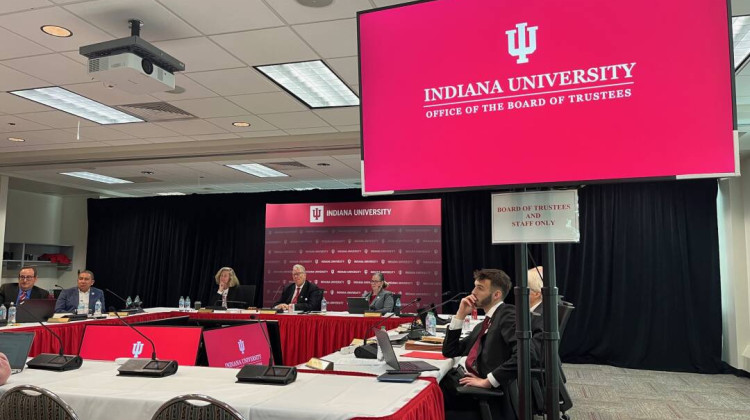
In this artist rendering, solar panels are added to the roof of Butler Lab School 60 in the Indianapolis Public School district. The panels are expected to offset the building's power by 82 percent as part of a district wide plan to add solar panels to 20 school facilities.
Courtesy of Sun FundED, Indianapolis Public SchoolsIndianapolis Public Schools is set to have the largest school solar project in the state. Last week district officials approved an agreement with a Carmel-based nonprofit to install solar panels at 20 school buildings. Sun FundED said all together it will be an installed capacity of more than eight megawatts — nearly three times larger than the next largest school solar project.
IPS’s project got underway just in time. People and groups who install solar panels after July 1 will get paid less money for the extra energy they deliver back to the grid — which will make solar less affordable.
In 2014, Indiana ranked near the bottom for solar projects at schools. Sun FundED co-founder Patrick Poer said that changed when schools realized those higher rates were going away. By 2019, Indiana ranked 5th in the nation for installed solar capacity at schools.
“Many schools seeing the advantage that that policy provides have accelerated their adoption,” Poer said.
IPS will work with Sun FundED to place solar panels on building roofs or on land next to facilities in order to reduce energy costs and cut carbon emissions. The installation process will take roughly one to two years. The service contract will allow Sun FundED to manage the entire process, such as engineering, purchasing solar panels and hiring electricians.
Join the conversation and sign up for the Indiana Two-Way. Text "Indiana" to 73224. Your comments and questions in response to our weekly text help us find the answers you need on statewide issues, including this series on climate change and solutions.
The district will pay the company a service fee after all the solar panels are fully operational. The cost is projected to be about $1.1 million in the first year.
“That stabilizes and makes budgeting more predictable for schools while creating a long-term hedge against cost-plus inflation,” said Weston Young, IPS chief financial officer, in a press release.
IPS is projected to save about $120,000 in utility costs within the first year and save roughly $40 million over the next 30 years. IPS classes will also have the opportunity to adopt digital programs that teach students about renewable energy and sustainability, and the financial and technical aspects of solar energy.
During IPS’ Thursday board meeting, commissioner Kenneth Allen said he wants the demographics of the contractors working on the solar panels to be as diverse as possible.
“I would encourage you and recommend that you do everything that you can to make sure that when this project hits the ground running, that we see people that are a reflection of the students and families that are represented in our district,” Allen said.
The Indiana NAACP is also working on a statewide initiative that, among other things, works to create solar jobs for unemployed, underemployed, and formerly incarcerated Hoosiers.
In 2020, IPS was one of three K-12 districts to become U.S. Department of Energy Goal Achievers for their work reducing energy usage by 26 percent. The district was also recognized in April for upgrading some of its facilities and making them Energy Star certified buildings.
Contact WFYI education reporter Elizabeth Gabriel at egabriel@wfyi.org or follow her on Twitter at @_elizabethgabs. Contact reporter Rebecca at rthiele@iu.edu or follow her on Twitter at @beckythiele.
Indiana Environmental reporting is supported by the Environmental Resilience Institute, an Indiana University Grand Challenge project developing Indiana-specific projections and informed responses to problems of environmental change.
 DONATE
DONATE








 Support WFYI. We can't do it without you.
Support WFYI. We can't do it without you.